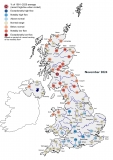Submitted by Eugene Magee on
Although bookended by unsettled conditions, some crisp temperatures and heavy rainfall, September rainfall was only slightly above average at the national scale, and did little to alleviate long-term rainfall and river flow deficits that have been developing over much of the last year. Reflecting this, September mean river flows were generally in the normal range to notably low, even in regions which had plentiful rainfall. A handful of catchments registered exceptionally low flows, with two new September minima recorded in southern England. Although soils started to wet up through September, for the most part they remained drier than normal at month-end. Groundwater levels continued to recede across the country. Below normal levels were observed in two thirds of index sites, with some exceptionally low levels on the south coasts of England and Wales. Several more regions of Wales were moved into drought, meaning all of Wales and all but three regions of England were in official drought status by month-end. Reservoir stocks for England & Wales were almost 25% below average. Stocks in many impoundments fell relative to average, Roadford substantially so by 24%, and some set new September minimum stocks (e.g. Elan Valley, Stithians and Wimbleball, in series of at least 35 years). The Outlook for the coming three months suggests that late autumn/early winter rainfall is unlikely to be significantly above average in areas of the south and east where this period is critical for replenishing water resources. Given this delayed start to the recharge season, it is very likely that the current drought situation will persist into 2023.



